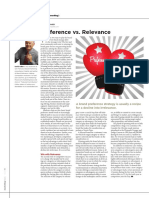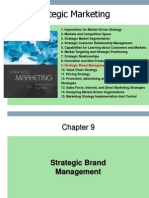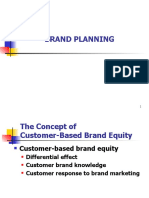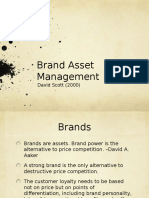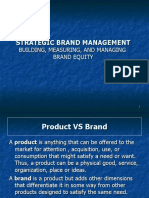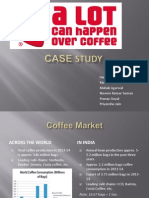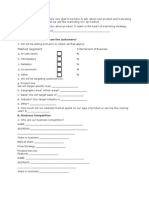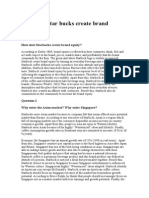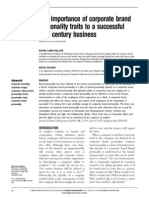S 12 Branding
S 12 Branding
Uploaded by
mahakagrawal3Copyright:
Available Formats
S 12 Branding
S 12 Branding
Uploaded by
mahakagrawal3Original Description:
Copyright
Available Formats
Share this document
Did you find this document useful?
Is this content inappropriate?
Copyright:
Available Formats
S 12 Branding
S 12 Branding
Uploaded by
mahakagrawal3Copyright:
Available Formats
Branding and Brand Equity
Session 11
Learning Outcomes
Describe the principles of branding and explain the
different types of brands
Understand the fundamentals of brand equity, and its
management.
Understand the important decisions in developing a
branding strategy.
Review Interbrands global ranking and Brand Equity
Indian Brands ranking
Review the 22 Immutable Laws of Branding
Cinthol
Launched in 1956. Stayed as a single product for three
decades. Re-launched on freshness platform.
Variants such as Cinthol Lime, Cinthol Fresh, Cinthol
Cologne, Cinthol Deo, Cinthol Fresh Aqua.
Brand extension to include deodorant sprays and talcum
powder.
Main target Indian outdoor man.
Use of film stars as brand ambassadors to communicate the
freshness and deodorant promise.
Change in portfolio, communication, packaging and other
marketing mix keeping the same basic promise.
Brand and Branding
4
A brand is a name, term, sign, symbol or design,
or a combination of them, intended to identify the
goods or services of one seller or group of sellers
and to differentiate them from those of
competitors.
Branding is endowing products and services with
the power of the brand.
What was the origin of the word brand and branding?
The Role of Brands
5
Identify the
maker
Help in
differentiation
Develop
customer
loyalty
Assist in
integrated
marketing
communication
Signify quality
Serve as a
competitive
advantage
Secure price
premium
Contribute to
corporate
identity
programme
Provide legal
protection
Brand Equity
Measure of the value of a brand in terms of the
customer viewpoint.
Three key ingredients of consumer based equity are:
Differences in consumer responses. Lack of differences
result in prices being the main deciding factor.
Consumers brand knowledge through images,
experiences and beliefs.
Perceptions, preferences and behaviour.
It results in better prices, market shares and
profitability.
Advantages of Strong Brands
7
Improved
perceptions of
product
performance.
Greater loyalty.
Less vulnerability
to competitive
marketing actions.
Less vulnerability
to marketing
crises.
Larger margins.
More inelastic
consumer
responses to price
changes.
Greater trade
cooperation and
support.
Increased
marketing
communication
effectiveness.
Additional brand
extension
possibilities.
Possible licensing
opportunities.
Greater financial
market returns
Brand Equity Models
Brand Asset Valuator (BAV)
Brandz
Brand Resonance Model
8
Brand Asset Valuator
Developed by Young and Rubicam based on research
with 800,000 customers across 51 countries.
It compares the brand equity of thousands of brands
across hundreds of categories.
The Four Brand Pillars of BAV
Differentiation has three important components
Different (Standing Out) Unique (Brand Personality) and
Distinctive (Brand Prestige and Pricing Power)
As brands mature differentiation declines
Relevance is the factor that attracts and retains the
customers. It is the staying power.
Esteem the extent to which consumers like a brand and
hold it in high regard. It denotes popularity and quality.
Knowledge Customers have understood what the brand
stands for
Measuring the relationship among the four pillars is crucial
in diagnosing the health of the brand.
10
Brand Strength and Brand Stature
11
Brand Asset
Valuator
Brand
Strength
Brand
Stature
Differentiation
Relevance Esteem Knowledge
POTENTIAL FOR
GROWTH
CURRENT
STRENGTH
LEADING LAGGING
Brands ability to defend itself
and generate economic value
Brands pervasiveness in the market. It
declines after brand strength erodes.
BAV Power Grid
12
Brand Dynamics Pyramid
Nothing else beats it Bonding
Does it offer some thing
better than others?
Advantage
Can it deliver? Performance
Does it offer me
some thing ?
Relevance
Do I know
about it?
Presence
Strong Relationship
High share of category
expenditure
Weak Share
Low share of category
expenditure
13
Developed by Millward Brown and WPP. Brand building follows a sequential series
of steps, each contingent upon successfully accomplishing the preceding one
Brand Resonance Pyramid
Building Brand Equity
15
Brand elements
Integrated marketing activities
Brand associations
Brand Elements
16
Branding
Jingles
..\Videos\AirTel Ad -
A.R.Rahman.mp4
..\Videos\Airtel old.flv
..\Videos\Boss Film The
Smartphone Network.mp4
Characters
Logos
URLs
Slogans
Brand Name
Symbols
www.amazon.com
Brand Elements
17
Brand element choice criteria
Memorable and short
Meaningful and credible
Likeable and appealing
Transferable across products and geographies
Adaptable and updatable
Protectable should not become generic
Developing brand elements
Should be inherently descriptive and persuasive.
Should capture intangible benefits LIC, Welcomgroup
Designing Holistic Activities
18
Brands are built through different touch points and
not only through advertising.
Brand contacts are now being made through:
Consumer communities
Events marketing
Sponsorships
Interactions with company personnel
Social cause marketing
Integrated marketing activities across product,
packaging, price, place and promotion.
Leveraging Secondary Associates
Brand Equity can also be built
by linking the brand to other
information in customer
memory
Links can be to:
Company
Geography
Other brands
Characters
Endorsements
Sponsorships
Awards
19
Brand Communities
A business strategy not a marketing strategy.
Meant to serve the people that comprise them.
Cultivate the communities and the brand will grow.
Communities should have advocates as well as critics.
They should not concentrate only the opinion leaders
but build the community as a whole.
Social networks are only a tool and not the strategy.
Successful brand communities need not be manged
and controlled.
Measuring Brand Equity
21
Marketing
Program
Investment
Customer
Mind-set
Brand
Performance
Shareholder
Value
VALUE
STAGES
Product
Communication
Trade
Employee
Other
Awareness
Associations
Attitudes
Attachments
Activities
Price premiums
Price elasticities
Market share
Expansion success
Cost structure
Profitability
Stock Price
P/E Ratio
Market
Capitalisation
Program
Multiplier
Customer
Multiplier
Market
Multiplier
Clarity
Relevance
Distinctiveness
Consistency
Competitive reactions
Channel support
Customer size and
profile
Market dynamics
Growth potential
Risk profile
Brand contribution
MULTIPLIERS
Interbrand Brand Valuation Method
On a 100 point
scale using 10
dimensions
Net Operating Profit After Tax
Weighted average cost of Capital
Difference = Economic Profit
calculated for five year forecast
Demand for a brand
in excess of demand
if unbranded
conducted through
survey, expert panel
and historical data
Inverse of brand
strength on an
algorithm scale
Top Ten Global Brands - 2013
RANK
LY
Rank
BRAND
VALUE
$ million
CHANGE
1 2 Apple 98,316 +28%
2 4 Google 93,291 +34%
3 1 Coca Cola 79,213 +2%
4 3 IBM 78,808 +4%
5 5 Microsoft 59,546 +3%
6 6 GE 46,947 +7%
7 7 McDonalds 41,992 +5%
8 9 Samsung 39,610 +20%
9 8 Intel 37,257 -5%
10 10 Toyota 35,346 +17%
01-23
Source: Best Global Brands 2013 by Interbrands
Indias Top Brands - 2014
24
Indias Top Brands - 2014
25
Indias Top Brands - 2014
26
Indias Top Brands - 2014
27
Indias Top Brands - 2014
28
Branding
Types Names
29
Manufacturer Brands
Private Label Brands
Generic Brands
Individual names
Blanket family names
Corporate name individual
name combination
Devising a Branding Strategy
30
Develop new brand elements
Apply some of the existing brand elements
Use a combination of old and new branding elements
Branding Terms
31
All products sold under a particular brand
Brand line
Assortment of all brand lines
Brand mix
Specific brand lines made for a channel
Branded variants
Use of an established brand to introduce a new product
Brand extension
Combining new brand with an existing brand (parent brand)
Sub-brand
Expansion within category
Line extension
Expansion to other categories
Category extension
Licensing of brand names
Licensed product
Brand Portfolio
32
A set of all brands and brand lines a particular firm
offers for sale in a particular category or market
segment.
Basic principle is to maximise customer coverage and
avoid brand overlap.
Ability to add or drop brands to maintain suitable
portfolio
Roles played by brands in portfolios:
Flankers
Cash cows
Low end entry level
High end prestige
Brand Extensions
Advantages Disadvantages
33
Improved odds of new
product success
Cost reduction in launch
Renew interest and
reinforce parent brand
Line extension trap
Brand dilution
Cannibalisation effect
Losing out on building a new
strong brand
Cobranding
34
2007 McGraw-Hill Companies, Inc., McGraw-Hill/Irwin
Ingredient
Branding
Cooperative
Branding
Complementary
Branding
Types of
Cobranding
Brand Personality
Customers will align with brands which reflect their own personality
The 22 Immutable Laws of Branding
The power of a brand is inversely
proportional to its scope
The Law of
Expansion
A brand becomes stronger when
you narrow its focus
The Law of
Contraction
The birth of a brand is achieved
with publicity, not advertising
The Law of
Publicity
Once born, a brand needs
advertising to stay healthy
The Law of
Advertising
36
The 22 Immutable Laws of Branding
A brand should strive to own a word in
the mind of the consumer
The Law of the
Word
The crucial ingredient in the success of
any brand is its claim to authenticity
The Law of
Credentials
Quality is important, but brands are not
built on quality alone
The Law of
Quality
A leading brand should promote the
category not the brand
The Law of the
Category
37
The 22 Immutable Laws of Branding
In the long run a brand is nothing
more than a name
The Law of the
Name
The easiest way to destroy a brand
is to put its name on every thing
The Law of
Extensions
In order to build the category, a
brand should welcome other brands
The Law of
Fellowship
One of the fastest routes to failure is
giving a brand a generic name
The Law of the
Generic
38
The 22 Immutable Laws of Branding
Brands are brands. Companies are
companies. There is a difference
The Law of the
Company
What branding builds, sub-
branding destroys
The Law of
Sub-brands
There is a time and place to launch
a second brand
The Law of
Siblings
A brands logotype should be
designed to fit the eyes. Both eyes.
The Law of
Shape
39
The 22 Immutable Laws of Branding
A brand should use a colour that is
opposite of its major competitors
The Law of
Colour
There are no barriers to global branding.
A brand should know no borders.
The Law of
Borders
A brand is not built overnight. Success is
measured in decades, not years.
The Law of
Consistency
Brands can be changed, but only
infrequently and very carefully.
The Law of
Change
40
The 22 Immutable Laws of Branding
No brand will live
forever. Euthanasia is
often the best solution
The Law of
Mortality
The most important
aspect of a brand is its
single mindedness.
The Law of
Singularity
41
Next Session
42
Whats in a Name Case
Deliverables
Single sheet by all students
Power point by all groups
Reading Chapter 10
You might also like
- Aaker on Branding: 20 Principles That Drive SuccessFrom EverandAaker on Branding: 20 Principles That Drive SuccessRating: 4 out of 5 stars4/5 (2)
- Chapter 9 - Creating Brand EquityDocument40 pagesChapter 9 - Creating Brand Equityrabeeka7No ratings yet
- Strategic Brand Management Building Measuring and Managing Brand Equity 4th Edition Kevin Solutions ManualDocument11 pagesStrategic Brand Management Building Measuring and Managing Brand Equity 4th Edition Kevin Solutions ManualKeithRomeros100% (1)
- Joining Bonus Policy PDFDocument1 pageJoining Bonus Policy PDFmahakagrawal3No ratings yet
- Brand StrategyDocument46 pagesBrand Strategypriyasangtani89100% (1)
- Building Strong Brands (Review and Analysis of Aaker's Book)From EverandBuilding Strong Brands (Review and Analysis of Aaker's Book)No ratings yet
- Human Resource Management: Employee Testing and SelectionDocument22 pagesHuman Resource Management: Employee Testing and Selectionmahakagrawal3No ratings yet
- Strategic Brand ManagementDocument35 pagesStrategic Brand ManagementKrishna Chaitanya MadipalliNo ratings yet
- Brand Building & Brand ManagementDocument36 pagesBrand Building & Brand Managementmikhil.muraliNo ratings yet
- Managing Brand Over TimeDocument40 pagesManaging Brand Over TimeAbhishek Krishna100% (2)
- Session 1 - Introduction To Brands & Brand ManagementDocument31 pagesSession 1 - Introduction To Brands & Brand ManagementMuhamad Ibnu FauziNo ratings yet
- Wa0004Document6 pagesWa0004Muhammad UsamaNo ratings yet
- Kavin Keller Brand Management CH 1Document35 pagesKavin Keller Brand Management CH 1Ria Rianti100% (1)
- Creating Brand EquityDocument36 pagesCreating Brand EquityFaisal MuftiNo ratings yet
- Brands&BrandingDocument34 pagesBrands&BrandingAbhilash VanamaNo ratings yet
- Creating Brand EquityDocument9 pagesCreating Brand Equityzubdasyeda8No ratings yet
- Brand StrategyDocument23 pagesBrand StrategyBarkha VermaNo ratings yet
- Brands and Brand ValuesDocument18 pagesBrands and Brand ValuesChalani KaushalyaNo ratings yet
- Marketing Strategy and PlansDocument36 pagesMarketing Strategy and Planssachindhule70No ratings yet
- Brand 240313231646 8e4e97caDocument59 pagesBrand 240313231646 8e4e97casharad.guptaNo ratings yet
- Branding... Chap 1XXXDocument169 pagesBranding... Chap 1XXXKazim AliNo ratings yet
- Cfakepathbranding Forupload 100510001427 Phpapp02Document35 pagesCfakepathbranding Forupload 100510001427 Phpapp02Antonette BunagNo ratings yet
- MrktingDocument11 pagesMrktinganindyaaus2007No ratings yet
- Strategic Brand ManagementDocument6 pagesStrategic Brand ManagementSe SathyaNo ratings yet
- BrandDocument38 pagesBrandramrattang100% (1)
- Brand Relevance - 1Document2 pagesBrand Relevance - 1Ayan PandaNo ratings yet
- Chapter 7 PDFDocument22 pagesChapter 7 PDFNgọc Nhung VũNo ratings yet
- Creating Brand EquityDocument32 pagesCreating Brand Equityibekmamad2100% (2)
- Strategic Brand ManagementDocument37 pagesStrategic Brand Managementcalmchandan100% (1)
- FinalDocument45 pagesFinalAnimesh TiwariNo ratings yet
- SBMDocument19 pagesSBMkarobikushalNo ratings yet
- MSCA - Product and Brand MBA 2011-13Document45 pagesMSCA - Product and Brand MBA 2011-13Parag ShettyNo ratings yet
- Crafting The Brand Positioning - 11Document3 pagesCrafting The Brand Positioning - 11skillfullyards100% (1)
- Brand ManagementDocument261 pagesBrand Managementmohamed rafaatNo ratings yet
- CH 5 Branding: Branding Building Brand EquityDocument34 pagesCH 5 Branding: Branding Building Brand EquityapiNo ratings yet
- Chapter 11 - GE - Fin - StudentsDocument43 pagesChapter 11 - GE - Fin - StudentsTasnova Lutfor 1825062090No ratings yet
- Concepts of Brand ManagementDocument263 pagesConcepts of Brand ManagementMartin Guy Choquette89% (9)
- Ndub BrandDocument11 pagesNdub BrandLenin VincentNo ratings yet
- Brand EquityDocument16 pagesBrand EquityFaRaz SharNo ratings yet
- Brand Growth Strategies - Brand ManagementFinalDocument82 pagesBrand Growth Strategies - Brand ManagementFinalmhlak100% (1)
- Branding & Brand Management - Week1Document20 pagesBranding & Brand Management - Week1EvakzNo ratings yet
- Brand ManagementDocument5 pagesBrand ManagementAtul LamaneNo ratings yet
- Designing & Implementing Branding StrategiesDocument39 pagesDesigning & Implementing Branding StrategiesRiotri Tanzisha100% (2)
- Branding & Business Strategy in The Value Delivery Process: by Bolaji OkusagaDocument26 pagesBranding & Business Strategy in The Value Delivery Process: by Bolaji OkusagaBolaji OkusagaNo ratings yet
- Creating Brand Equity: Prepared By: Sayed Momin HashemiDocument27 pagesCreating Brand Equity: Prepared By: Sayed Momin Hashemieiraj hashemiNo ratings yet
- Unit-5 Designing and Implementing Brand Strategies Designing and Implementing Brand StrategiesDocument6 pagesUnit-5 Designing and Implementing Brand Strategies Designing and Implementing Brand Strategiesnidhi dubeyNo ratings yet
- Brand Management Exercises For 2016Document70 pagesBrand Management Exercises For 2016shashi shekharNo ratings yet
- BrandsDocument12 pagesBrandsdostmuhammad18No ratings yet
- Brand 090331060104 Phpapp01Document40 pagesBrand 090331060104 Phpapp01Sajid KhattakNo ratings yet
- Introduction To Branding: by Robert Jones (Author)Document42 pagesIntroduction To Branding: by Robert Jones (Author)Miko Irwanto100% (1)
- Brand Management Unit 1-2Document24 pagesBrand Management Unit 1-2santhosh46kannanNo ratings yet
- B2B BrandingDocument26 pagesB2B BrandingJawad Arshed100% (1)
- Brand Management: Legal Protection Given To A Brand Name Is Called A TrademarkDocument7 pagesBrand Management: Legal Protection Given To A Brand Name Is Called A TrademarkVishal Singh JaswalNo ratings yet
- Strategic Brand Management Final C3a7alc4b1c59fmasc4b11Document15 pagesStrategic Brand Management Final C3a7alc4b1c59fmasc4b11Trúc Nguyễn ThanhNo ratings yet
- Brand ManagementDocument59 pagesBrand ManagementAbc AbcNo ratings yet
- Brand Asset Management Slide 1Document29 pagesBrand Asset Management Slide 1Tiffany TanNo ratings yet
- SBM PDF NotesDocument63 pagesSBM PDF NoteshaloangleNo ratings yet
- Strategic Brand ManagementDocument36 pagesStrategic Brand ManagementJayadtiya Singh jasolNo ratings yet
- Marketing Management: Creating Brand EquityDocument31 pagesMarketing Management: Creating Brand EquityBilal Raja100% (1)
- Brand Creation: Offensive & Defensive Competitive AdvantageDocument21 pagesBrand Creation: Offensive & Defensive Competitive AdvantageYuszaizie Mohd PauzeeNo ratings yet
- Brand-Leadership (Review and Analysis of Aaker and Joachimsthaler's Book)From EverandBrand-Leadership (Review and Analysis of Aaker and Joachimsthaler's Book)No ratings yet
- Travel Policy - India W IDC PDFDocument30 pagesTravel Policy - India W IDC PDFmahakagrawal3No ratings yet
- Referral Policy - Annexure For IDC PDFDocument1 pageReferral Policy - Annexure For IDC PDFmahakagrawal3No ratings yet
- Policy No. / Version: HR / 002 Policy Effective: 01-May-14 Approved By: HR Director / Finance Director Prepared By: HR ManagerDocument12 pagesPolicy No. / Version: HR / 002 Policy Effective: 01-May-14 Approved By: HR Director / Finance Director Prepared By: HR Managermahakagrawal3No ratings yet
- Mobile Reimbursement Policy - 2014 PDFDocument3 pagesMobile Reimbursement Policy - 2014 PDFmahakagrawal3No ratings yet
- India - Relocation Policy - 2014 PDFDocument5 pagesIndia - Relocation Policy - 2014 PDFmahakagrawal3100% (1)
- Sonoco Products Company Case GroupDocument13 pagesSonoco Products Company Case Groupmahakagrawal3No ratings yet
- PG 642-646 (Part4) Chapter 17Document5 pagesPG 642-646 (Part4) Chapter 17mahakagrawal3No ratings yet
- Holiday List 2015 PDFDocument1 pageHoliday List 2015 PDFmahakagrawal3No ratings yet
- Coaching Careers and Talent ManagementDocument31 pagesCoaching Careers and Talent ManagementRingga Arie SuryadiNo ratings yet
- HRM CH 8Document30 pagesHRM CH 8mahakagrawal350% (2)
- Chapter 11 12 13 Khitij FinalDocument37 pagesChapter 11 12 13 Khitij Finalmahakagrawal3No ratings yet
- Slide 7 and 8Document2 pagesSlide 7 and 8mahakagrawal3No ratings yet
- HRM CH 7Document10 pagesHRM CH 7mahakagrawal3No ratings yet
- 0000002709-HRM Ch. 4Document16 pages0000002709-HRM Ch. 4mahakagrawal3No ratings yet
- Group 2 - Detailed Report - Part 1Document14 pagesGroup 2 - Detailed Report - Part 1mahakagrawal3No ratings yet
- Personnel Planning and Recruiting: Global Edition 12eDocument52 pagesPersonnel Planning and Recruiting: Global Edition 12emjrNo ratings yet
- Chapter 6-7 IshanaDocument16 pagesChapter 6-7 Ishanamahakagrawal3No ratings yet
- Case Study On: Google IncDocument20 pagesCase Study On: Google Incmahakagrawal3No ratings yet
- FMG23B - Group 2 - Consumer Behaviour Project - Part 2Document7 pagesFMG23B - Group 2 - Consumer Behaviour Project - Part 2mahakagrawal3No ratings yet
- Harjas Kaur Kanika Jain Mahak Agarwal Naveen Kumar Suman Pranay Goyal Priyanshu JainDocument15 pagesHarjas Kaur Kanika Jain Mahak Agarwal Naveen Kumar Suman Pranay Goyal Priyanshu Jainmahakagrawal3No ratings yet
- GUGUGUGUGUGUGUGUGUGUDocument98 pagesGUGUGUGUGUGUGUGUGUGURohit SharmaNo ratings yet
- Branding 101Document6 pagesBranding 101Godwill SwanzyNo ratings yet
- Brand Management NotesDocument17 pagesBrand Management NotesNishant Sood100% (1)
- Kolářík 2013 BP PDFDocument71 pagesKolářík 2013 BP PDFsameer issaNo ratings yet
- A Conceptual Framework For Understanding Consumer Based Brand Equity (Vukasovic 2016)Document7 pagesA Conceptual Framework For Understanding Consumer Based Brand Equity (Vukasovic 2016)Renzo Aranda BalcazarNo ratings yet
- Bachelor in Business Administration: (Assignment 1)Document7 pagesBachelor in Business Administration: (Assignment 1)yana kiutNo ratings yet
- Documentmass 3658Document52 pagesDocumentmass 3658dominique.neihart714No ratings yet
- Testing UploadDocument110 pagesTesting UploadArjun CardozaNo ratings yet
- MKT460.6 Esquire Group Case Study Group UpdatedDocument10 pagesMKT460.6 Esquire Group Case Study Group UpdatedOmar Fahim Khan 1911758030No ratings yet
- Fardapaper Exploring The Effect of Starbucks Green Marketing On Consumers Purchase Decisions From Consumers' PerspectiveDocument14 pagesFardapaper Exploring The Effect of Starbucks Green Marketing On Consumers Purchase Decisions From Consumers' PerspectiveAsora Yasmin snehaNo ratings yet
- Master Thesis Rens VerweijDocument78 pagesMaster Thesis Rens VerweijRens VerweijNo ratings yet
- Keller 2010 Brand Equity Management in A Multichannel Multimedia Retail EnvironmentDocument13 pagesKeller 2010 Brand Equity Management in A Multichannel Multimedia Retail EnvironmentZoe WongNo ratings yet
- Burger KingDocument4 pagesBurger KingRajaram IyengarNo ratings yet
- Brand Value ChainDocument79 pagesBrand Value ChainNeetu GsNo ratings yet
- Brand Perception of Honda ProductsDocument64 pagesBrand Perception of Honda ProductssheelasweetyNo ratings yet
- Brand Equity in Coca-ColaDocument12 pagesBrand Equity in Coca-ColaSohaib ArifNo ratings yet
- Production Mix of K&N'SDocument5 pagesProduction Mix of K&N'SAdnan AbdullahNo ratings yet
- Ice Cream ProjectDocument53 pagesIce Cream Projectblackrose_nhungNo ratings yet
- BBA VI SEM E1 Brand Management Module 5 Brand Leverage and Performance - Anita KurianDocument69 pagesBBA VI SEM E1 Brand Management Module 5 Brand Leverage and Performance - Anita KurianAnita KurianNo ratings yet
- CCD AnalysisDocument7 pagesCCD AnalysisBenjamin Chavez100% (1)
- How Does Star Bucks Create Brand EquityDocument6 pagesHow Does Star Bucks Create Brand Equitybrojas35No ratings yet
- Brand EquityDocument69 pagesBrand EquityVinay SuriNo ratings yet
- Master of Management in Strategic MarketingDocument8 pagesMaster of Management in Strategic MarketingNayan SamantaNo ratings yet
- Literature Review On Brand AwarenessDocument6 pagesLiterature Review On Brand Awarenessrykkssbnd100% (1)
- Study of Effective Brand Management at Edainfront Solutions PVT LTD"Document48 pagesStudy of Effective Brand Management at Edainfront Solutions PVT LTD"neekuj malik100% (1)
- Marketing Mix - Product-NPD PLC Brand Packaging LabelingDocument39 pagesMarketing Mix - Product-NPD PLC Brand Packaging LabelingBilal Maqsood100% (1)
- Vadilal Summer Project PDFDocument59 pagesVadilal Summer Project PDFDeepesh RathodNo ratings yet
- Brand Equity Dissertation PDFDocument8 pagesBrand Equity Dissertation PDFCheapestPaperWritingServiceSingapore100% (1)
- The Importance of Corporate Brand Personality Traits To A Successful 21st Century BusinessDocument8 pagesThe Importance of Corporate Brand Personality Traits To A Successful 21st Century Businessmultanigazal_4254062No ratings yet
- An Application of Keller's Brand Equity Model in A B2BDocument30 pagesAn Application of Keller's Brand Equity Model in A B2BMusic Lover100% (1)

























